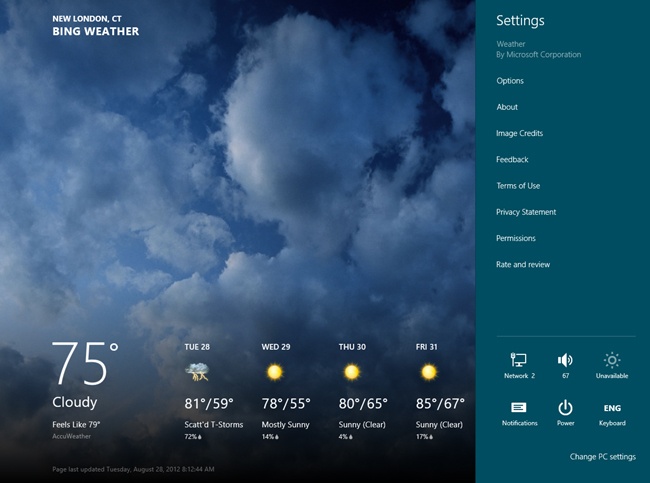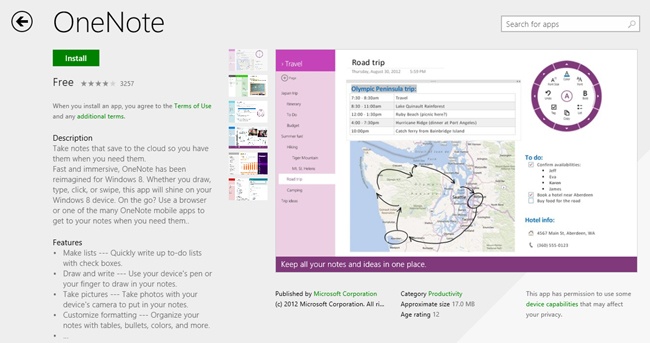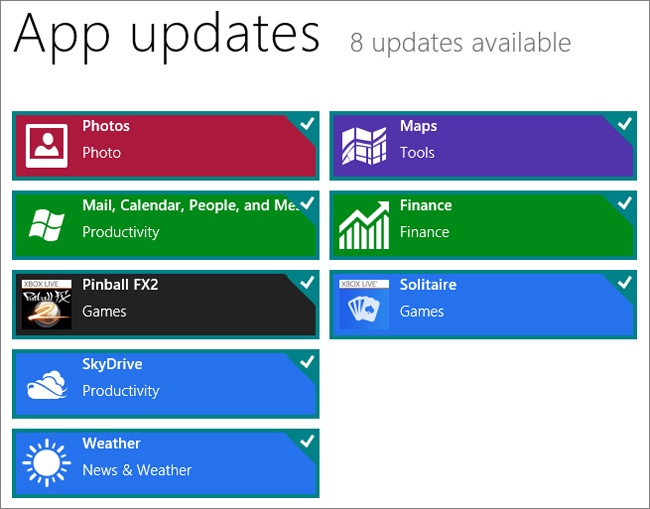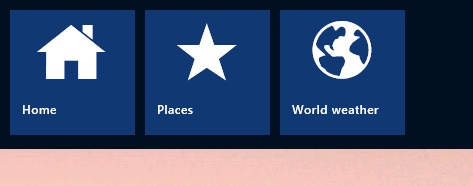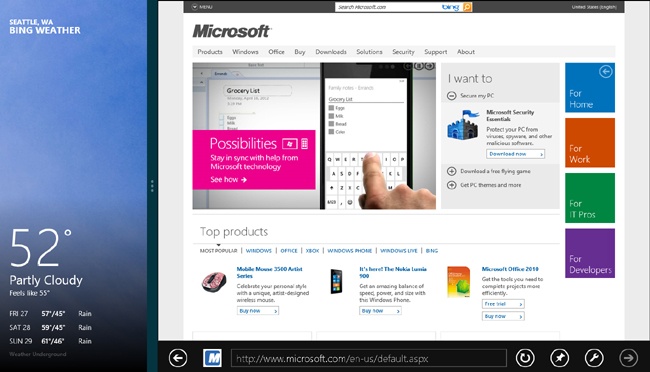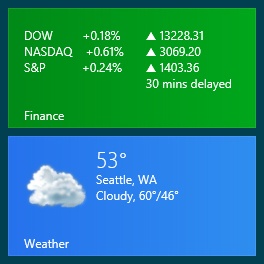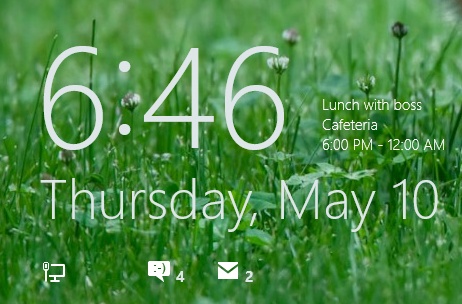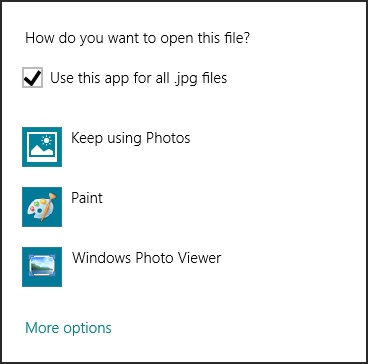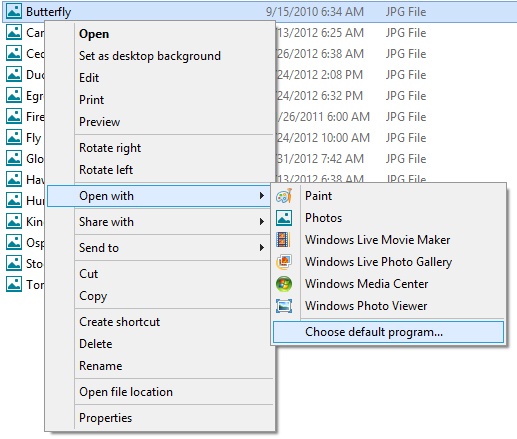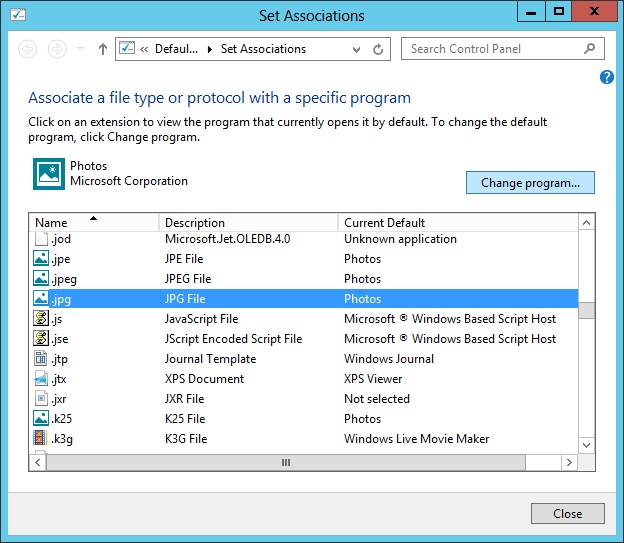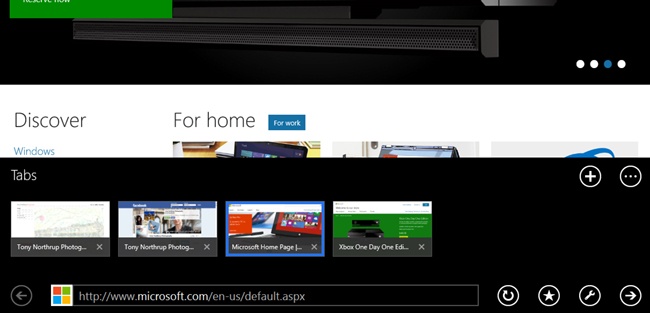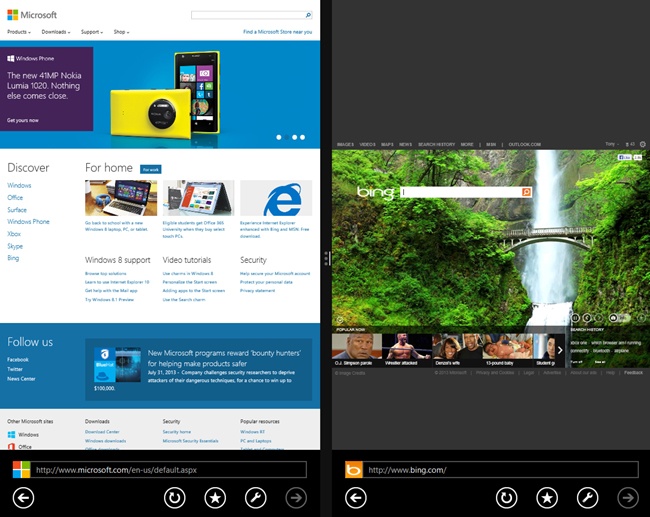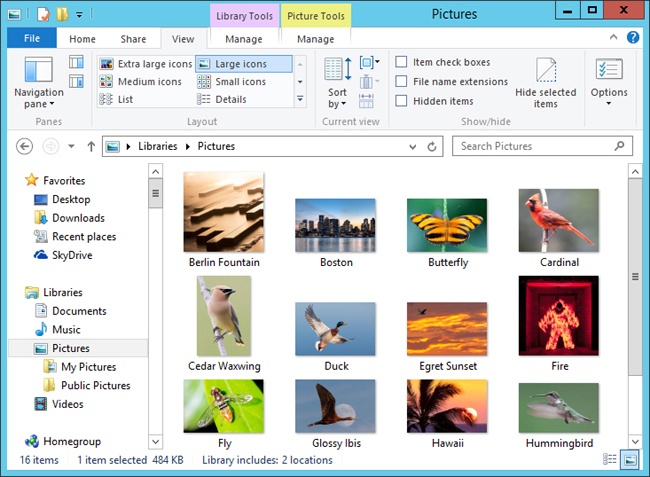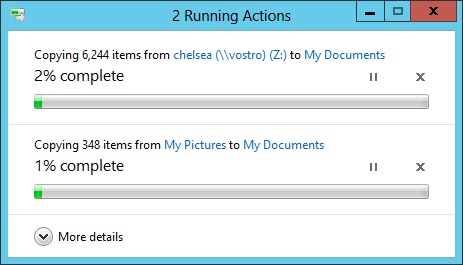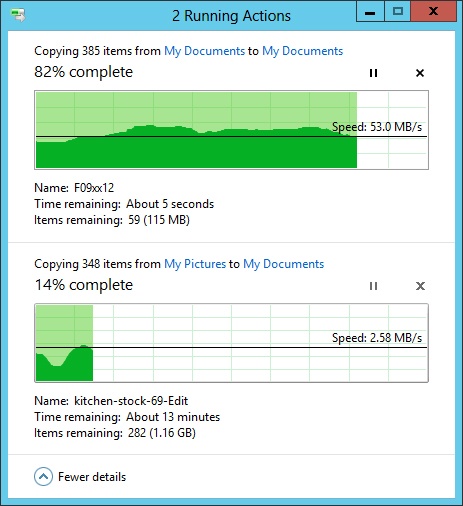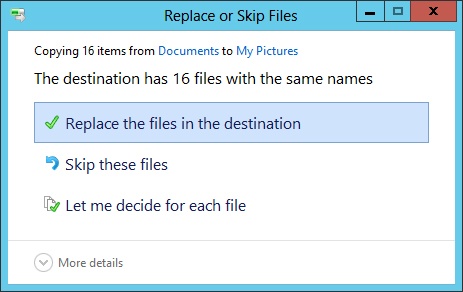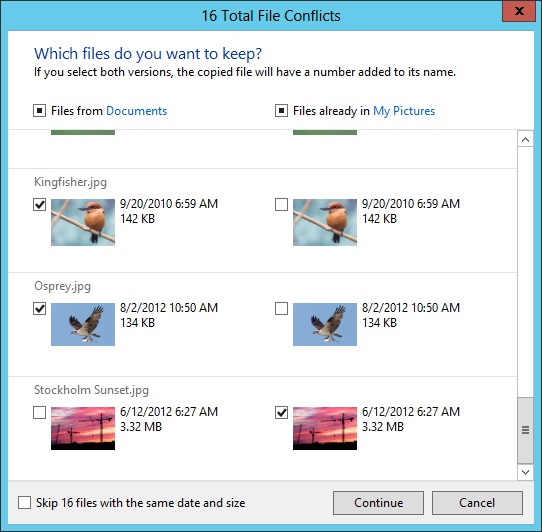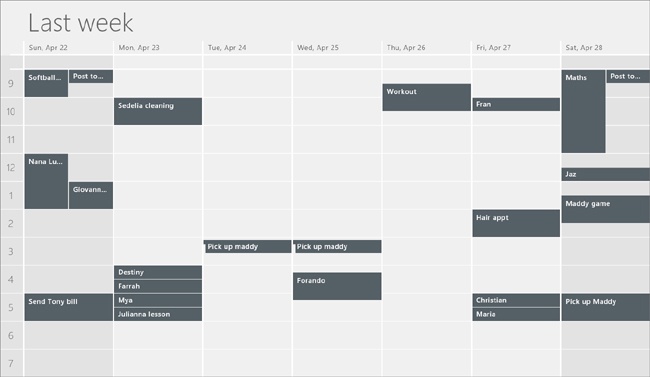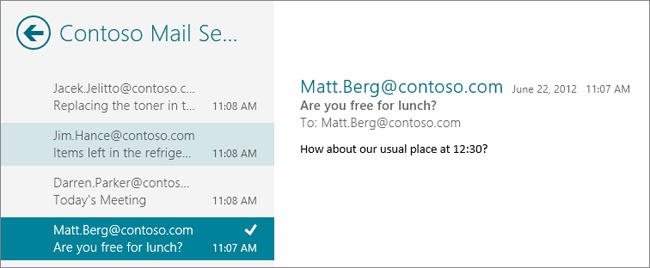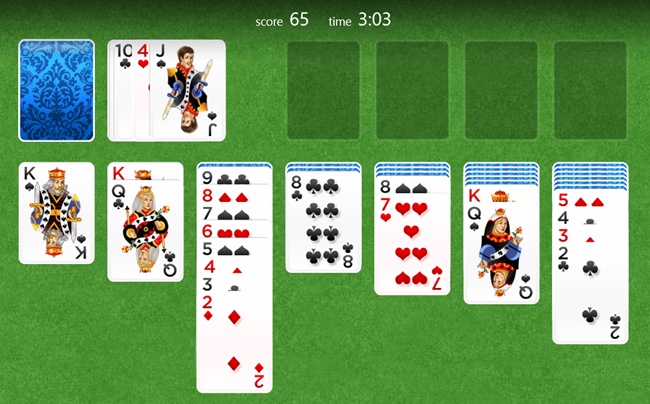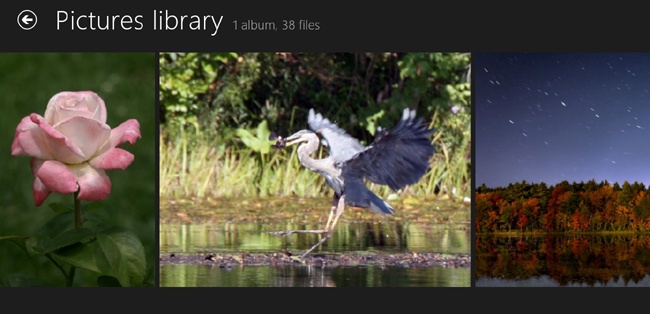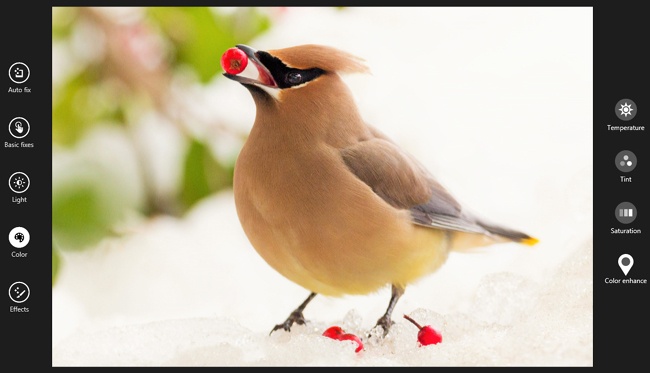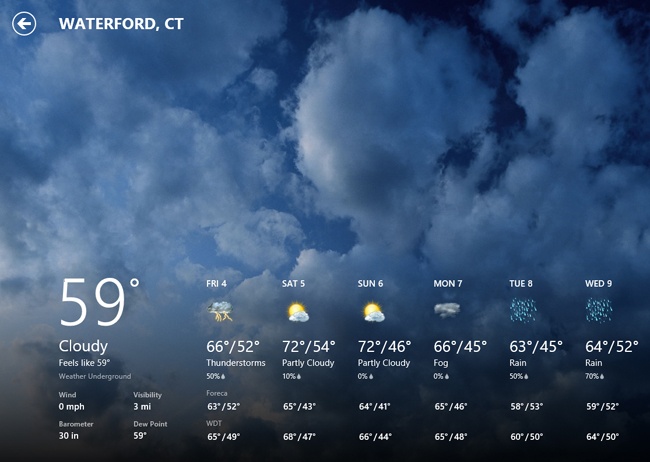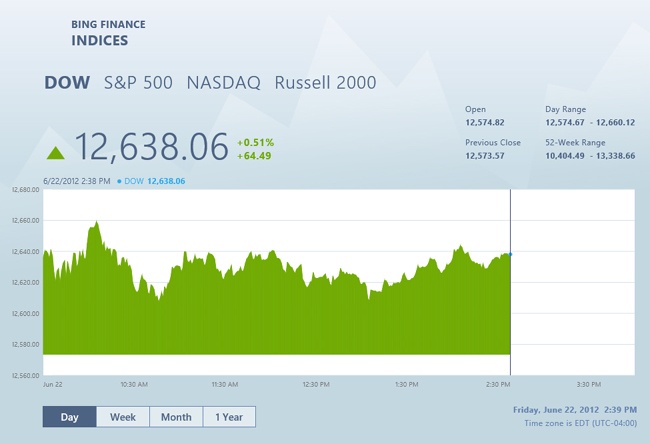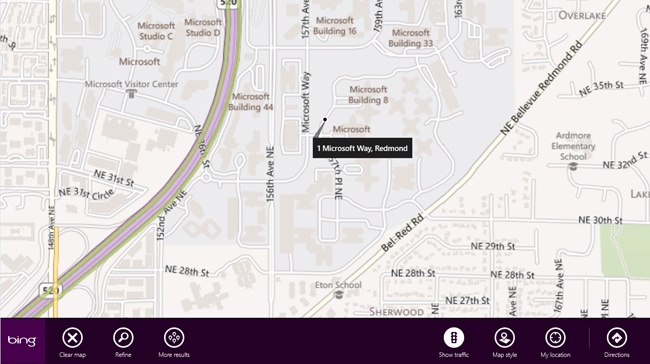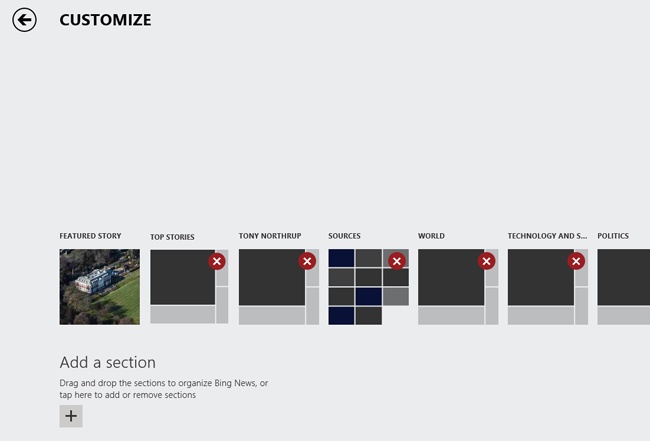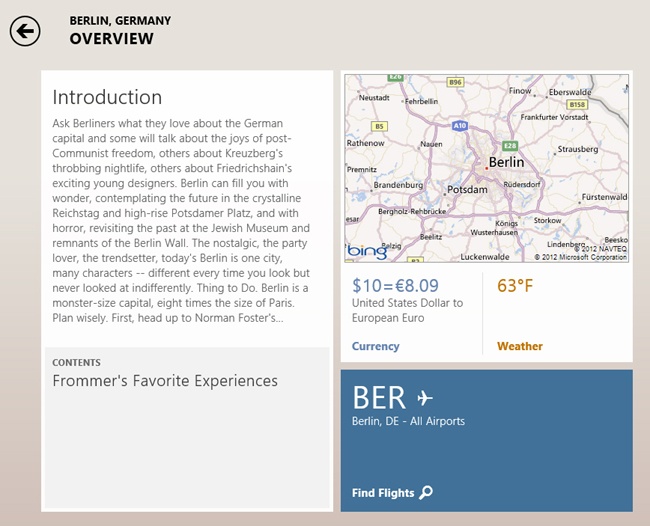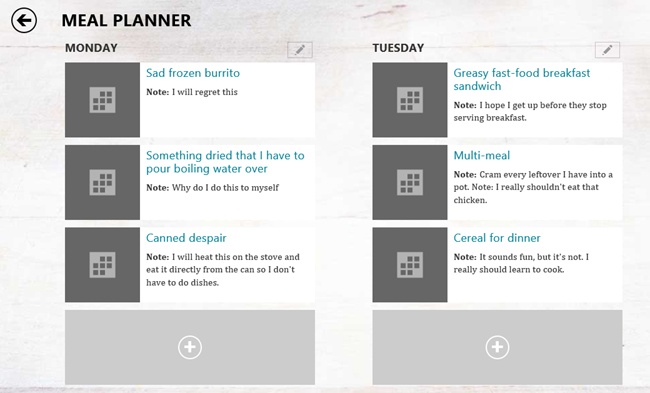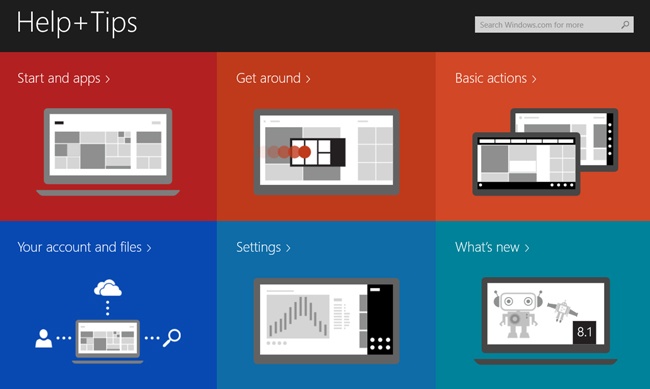Windows 8.1 supports a new type of app designed for modern, mobile, and touch-enabled PCs. This new type of app provides many benefits:
Integration with the Windows 8.1 user interface for settings, sharing, and notifications
Background apps automatically suspend to maximize performance and battery life
Full-screen user interface maximizes desktop space
Support for ARM computers running Windows RT 8.1
Persistence through a PC refresh
Using and managing these apps requires very different skills. The Windows Store completely changes the way you find, download, and install apps. Familiar tasks, such as changing app options, are still available, but they’re out of sight by default. Right-clicking won’t work the way you expect it to, but you’ll quickly become familiar with the touch-friendly way of interacting with apps.
To provide compatibility with existing apps, Windows 8.1 and Windows 8.1 Pro can run the same desktop apps supported by Windows 7 and earlier versions of Windows, and those apps will continue to work exactly as you expect them to. Windows RT (the version of Windows 8.1 for computers with ARM processors) can run apps designed for Windows 8.1, but can’t run desktop apps.
This chapter provides an overview of Windows 8.1 apps and the specific apps that are included with Windows 8.1. None of the features described in this chapter apply to desktop apps, including those apps designed for Windows 7 and earlier versions of Windows. This chapter refers only to touch-friendly apps designed for Windows 8.1. For detailed information, refer to Chapter 6.
Apps created for Windows 7 and earlier versions of Windows require the app developer to determine the best way to implement common tasks such as configuring app settings, finding content with the app, and printing. Not only did this flexibility increase the amount of work developers needed to do, but it meant that developers chose to implement the same features in very different ways.
For example, many desktop apps allow the user to configure settings using the Options item on the Edit menu. However, some desktop apps store the Options item under the File or Tools menu. Internet Explorer 9 doesn’t display a menu bar by default, so users need to click a toolbar button to set options.
Inconsistency between apps is difficult for users. With Windows 8.1 apps, users access common features using charms. To see your charms, swipe in from the right using touch or press Windows+C on the keyboard. For more information about charms, refer to Chapter 1.
Note
Using charms Watch the video at http://aka.ms/WinIO/charms.
Windows 8.1 provides a common user interface for configuring app-specific settings and common system settings, as shown in Figure 2-1. To access settings and hidden menu items for the current app, press Windows+I.
If you log on to multiple computers with the same Microsoft account, app settings will roam with you to whichever computer you log on to.
By clicking the Settings charm (shortcut: Windows+I) and clicking Permissions, you can configure the resources an app can access, including your webcam, microphone, and the lock screen.
With Windows 8.1, your searches can find data within Windows 8.1 apps as well as files and folders on your computer. For example, a search could find a contact from the People app, stock data from the Finance app, or messages from the Mail app.
As a result, most apps won’t have their own search command. Instead, use the Search charm to search within any app. To quickly start a search using a keyboard, press Windows+F. For example, to find a new app in the Store by name, touch the Search charm, touch Store, and then type the name of the app. Similarly, to find music, touch the Search charm, touch Music, and then type the name of the artist.
Configure whether an app appears on the search bar by using the Search page of PC Settings.
You can share content from many Windows 8.1 apps by clicking the Share charm (shortcut: Ctrl+H). For example, from Internet Explorer, you can use sharing to easily email a link to a webpage (using the Mail app) or share it on Facebook or Twitter (using the People app). Any app can support sharing from any other app, so you can share with apps that are not included with Windows, too.
Configure whether an app can share from the Share page of PC Settings.
Windows 8.1 apps share a common convention for printing: the Devices charm. To print a document from within an app, tap the Devices charm and then follow the prompts that appear.
Microsoft has guidelines for Windows 8.1 app developers that will further improve consistency and usability. Most Windows 8.1 apps resume where you left off, as long as that content is still relevant. For example, Internet Explorer always returns you to the tabs you last had open, reading apps will open the book you were last reading to your current page, and games should return to your current spot without requiring you to load a saved game. Windows 8.1 apps can automatically roam settings and state, too, so you can have the same experience even if you switch between computers.
The sections that follow provide an overview of how users find, download, and use apps.
Apps designed for Windows 8.1 can be installed only by downloading them using the Store app. The Store provides a single interface for finding, buying (if an app is not free), downloading, and installing an app.
In previous versions of Windows, finding and installing a new app typically followed this process:
Search the web for an app.
If an app seems to meet your needs, determine whether you need to pay for it. If you do, progress through the website’s checkout process and provide your credit card information.
Follow the setup wizard to install the software.
If necessary, enter a product key, and record your software.
Because each software development company has its own website format, the process for buying, downloading, and installing each app was different. If the app had a free trial, users would have to return to the website later to purchase and register the app. Additionally, there was no reliable way to find user reviews.
The Store changes this for Windows 8.1 apps. Now the process is much simpler:
Open the Store from the Start screen to browse apps, or click the Search charm and select Store to search apps.
Select an app. The Store displays user reviews, the cost (if an app is not free), and the permissions the app needs for your computer, as shown in Figure 2-2. Click Buy or Try. If you buy the app, the Store confirms the purchase, asks you to retype your Microsoft account password, and then collects your payment information. You can pay with a credit card or PayPal, and Microsoft can save your credit card information so you don’t have to retype it each time.
Continue using Windows. Windows 8.1 notifies you when it has installed the app.
Only Windows 8.1 Pro computers that have been joined to an Active Directory domain can install apps without using the Store. This process is commonly known as sideloading, and the custom apps businesses add are called line-of-business (LOB) apps. Essentially, only business users can bypass the Store to install Windows 8.1 apps. While this restriction might not be popular among power users, you can still freely install desktop apps.
Note
Using apps designed for Windows 8.1 Watch the video at http://aka.ms/WinIO/apps.
Developers release app updates regularly. Most of the time, they’re just fixing a bug or two. Sometimes, they add new features or improve the user interface. Updates are usually a good thing.
On rare occasions, you might find an update that you don’t want. For example, the developer of a free app might add aggressive advertising to the app, or a developer might remove an important feature. It’s even possible that a developer will introduce a new bug that breaks an existing feature, a problem developers know as a regression.
By default, Windows 8.1 automatically downloads app updates and then prompts you to install them, as shown in Figure 2-3. This is the best situation for most people. You can’t configure apps to update automatically. Every update must be initiated by the user, but since Windows 8.1 has already downloaded the files, the update doesn’t take long.
You can manually check for updates by opening the Store, selecting the Settings charm, selecting App Updates, and then selecting Check For Updates. Because updates are automatic, you shouldn’t need to worry about them, but it’s good to know how to check just in case you hear about an important update that Windows hasn’t found yet.
Windows 8.1 apps don’t have menus. Instead, they have app commands that are displayed on a toolbar that appears at the bottom of the screen, the top of the screen, or both. Figure 2-4 shows the Weather app commands at the top of the screen.
To view app commands with the touch interface, swipe up from the bottom or down from the top of the screen. To view app commands with a mouse, right-click anywhere on the app.
Some Windows 8.1 apps, such as Internet Explorer, still provide right-click context menus.
If your computer’s display has a resolution of 1024x768 or greater, you can snap apps to the short side of a screen and use them alongside another app. To snap the current app, drag the top of the screen to one side. You can also touch or hover your pointer at the upper-left corner to display previously opened apps and then drag the app you want to snap to one side of the screen.
After you have snapped an app, you can drag the divider left or right to change how the apps share screen space. Apps have a minimum width, however, and that width is usually 320 pixels. Figure 2-5 shows the Weather app snapped to the left side of the screen, multitasking with Internet Explorer.
In the desktop environment (including the Windows 8.1 desktop), the user can make app windows any size. For example, a user might place a web browser on the top half of the screen and a word-processing app on the bottom half of the screen. Windows 8.1 continues to support this flexibility for desktop apps.
While all apps designed for Windows 8.1 support snapping, some apps won’t be useful when snapped, and they might simply display an icon. Even if an app does not display a user interface when snapped, snapping can still be a useful way to quickly flip between two apps.
To close a snapped app with the mouse or touch, swipe down from the top of the screen and then drag it to the bottom of the screen.
Apps designed for Windows 8.1 can update their tiles on the Start screen with relevant information. For example, as Figure 2-6 demonstrates, the Finance app displays current stock prices and the Weather app displays current conditions. Live tiles often give you the information you need from an app without having to open the app.
Windows 8.1 is designed to support hundreds of live tiles without substantially slowing your computer’s performance or reducing battery life. Windows 8.1 receives authenticated and encrypted updates to live tiles from the Windows Push Notification Services (WNS), a web service hosted by Microsoft for free use by Windows 8.1 customers and app developers. Because WNS provides updates for all apps, Windows 8.1 can update an app’s tile without starting the app itself. App developers can create custom web services to update WNS, and in turn live tiles, with up-to-the-minute text, data, and images.
Apps can also update live tiles while the app is running and on a scheduled or periodic basis. For example, the Windows Calendar app uses scheduled updates to display meeting notifications based on local calendar data, without communicating on the Internet. Live tiles can cycle through up to five updates.
Note
For detailed information, read “Updating live tiles without draining your battery” at http://blogs.msdn.com/b/b8/archive/2011/11/02/updating-live-tiles-without-draining-your-battery.aspx.
Use the App History tab of Task Manager to see the bandwidth used by live tiles.
Some Windows 8.1 apps allow you to use the Pin To Start option to add an extra tile to the Start screen. The new tile links you directly to content within an app, but otherwise it behaves exactly like an original tile. For example, a news app might allow users to create a tile for a specific news topic, such as technology news. The app could then update that tile with headlines and images from the latest technology news.
Windows 8.1 apps can display information on the lock screen, which allows users to get updates at a glance without logging on to their PC. Not all apps support displaying information on the lock screen.
You can configure up to seven apps to display information on the lock screen, with one app displaying a detailed status. Figure 2-7 shows a sample lock screen. On the right side of the screen, above the date, the Calendar app displays the details of the next meeting. Below the date, the icons show that the People app has four notifications, and the Mail app has two new messages.
To configure which apps can update the lock screen, use the Personalize page in PC Settings.
Windows 8.1 apps have several unique features that you won’t directly interact with. Desktop apps don’t have these features; only apps specifically designed for the Windows 8.1 touch interface do. For the curious, the sections that follow describe those features.
To improve system integrity and user privacy, Windows 8.1 apps run in a sandboxed environment that isolates the app’s data and minimizes the privileges the app has to the operating system and computer. Isolation improves security, reduces the risk of malware, and increases system stability.
Applications use resources even when you are not actively using them. In earlier versions of Windows, users needed to manage the apps they had open and remember to close apps they were no longer using. If a user left too many apps open, the computer would run low on memory or processor resources, and the computer’s performance would slow down. The computer would run out of battery power sooner, too.
Windows 8.1 automatically suspends Windows 8.1 apps that are not in use when it can make better use of the app’s memory. When Windows 8.1 suspends an app, Windows 8.1 writes the app’s memory to the hard disk without interfering with other disk input/output (I/O). If you are familiar with Windows hibernation, the process is similar, but for a single app.
Though Windows 8.1 makes a copy of the app’s memory on the hard disk, it leaves the contents of the app’s memory intact. If the user accesses the app before another app needs the memory space, Windows 8.1 resumes the app immediately without needing to read the memory contents from disk.
If the user accesses a suspended app and the app’s memory contents have been overwritten, Windows 8.1 immediately reads the app’s memory from the hard disk and resumes the app. The faster the computer’s disk is, and the smaller the app’s memory set is, the more responsive suspended apps will be. Specifically, solid-state disks (SSDs) will provide the best performance.
Apps consume no resources while in a suspended state, improving battery life and the performance of foreground apps. On computers with large amounts of memory, Windows 8.1 might never need to suspend apps. Operating system functions, such as copying files, continue in the background without being suspended. Windows 8.1 cannot suspend desktop apps.
Desktop apps continue to run even when they are not in the foreground. Though the user might not interact with them, desktop apps often perform background tasks such as retrieving data from the Internet. Sometimes, these background tasks are unnecessary and simply waste computing resources. At other times, however, they are important. For example, an instant messaging app needs to receive new messages, and a music app needs to play music.
Windows 8.1 apps are designed to be suspended when they are not in the foreground, minimizing the resources they use. However, Windows 8.1 apps can still perform background tasks triggered by a variety of different scenarios, including:
A message is received from the Internet.
A notification is received from the Windows Push Notification Services (WNS).
The Internet becomes available or unavailable.
The app is updated.
The user leaves or returns.
A specific time of day occurs.
A regular interval occurs.
Applications can restrict background tasks so that they run only when the computer is plugged in or a specific amount of network bandwidth is available. Windows 8.1 restricts the processing and network resources background tasks can use so that they will not consume too many resources. Apps on the lock screen receive the following processor and network time:
Two seconds of processor time every 15 minutes (a maximum of about 0.2% of the processor time)
Approximately 187 kilobytes (KB) of data for each megabit of network throughput every 15 minutes (about 0.2% of the available bandwidth), based on the amount of power required by the network adapter
Apps not on the lock screen receive even fewer resources:
One second of processor time every 2 hours (a maximum of about 0.01% of the processor time)
Approximately 187 KB of data for each megabit of network throughput every 15 minutes (about 0.03% of the available bandwidth), based on the amount of power required by the network adapter
The network restrictions are removed when the PC is connected to a power outlet.
Note
For more information, read “Introduction to Background Tasks” at http://www.microsoft.com/en-us/download/details.aspx?id=27411.
The primary way for browsing files with a touch interface is the SkyDrive app. Most of the time, you can simply select files and let Windows choose how to open them. If you’re not happy with the app Windows selects by default, you can change it. When you change a default app association, you change which app Windows uses to open all files with the same file name extension. For example, you could configure Windows to open all .jpg files with the Windows Photo Viewer desktop app instead of the Photos app.
From within SkyDrive, select a file instead of opening it. You can select a file by flicking it with your finger or right-clicking it with your mouse. Then, select Open With from the commands at the bottom of the screen. SkyDrive displays the dialog box shown in Figure 2-8, prompting you to select the app to open the file with.
Select More Options to view the full list of apps, including an option to download a new app from the Store. If you leave Use This App For All Files selected, Windows will use the selected app by default (even if you open a file from the desktop).
You can change the default app from the desktop, too. From File Explorer, right-click a file, click Open With, and, if the submenu is available, select Choose Default Program, as shown in Figure 2-9. If you simply select Open With and then the app you want to open the file with, you won’t change the default app used when you open the same file type in the future.
If you want to change the file association for multiple file types, here’s a quicker method:
From the Start screen search for associations and then select Change The File Type Associated With A File Extension.
Select a file association that you want to change, as shown in Figure 2-10. Then, select Change Program.
If you have a new app and you want it to handle every file type it is capable of opening, follow these steps:
From the Start screen search for default programs and then select Set Your Default Programs.
As shown in Figure 2-11, select the app you want to set as the default, and then select Set This Program As Default.
The apps built into Windows 8.1 work together. For example, starting the Mail app allows you to browse through the People app to select message recipients.
The sections that follow provide a high-level overview of Internet Explorer 11 and the People, Calendar, and Mail apps, among others.
Windows 8.1 includes two versions of Internet Explorer: a touch version and a desktop version. The desktop version of Internet Explorer 11 closely resembles Internet Explorer 9 running in Windows 7. When you launch Internet Explorer from the Start screen, however, you open the touch version of Internet Explorer, which provides a very different experience by default:
The display is touch-friendly and full-screen.
The user interface uses Windows 8.1–style buttons and icons.
The address bar (which is also used for searching) is at the bottom of the screen.
The address bar appears only before the user opens the first webpage and while pages are loading.
Click anywhere on a webpage to hide the toolbar buttons and address bar. Right-click or swipe up from the bottom to display toolbar buttons, the address bar, and tabs at the bottom of the screen, as shown in Figure 2-12.
The app commands include the Pin To Start button. Click this command to add the current webpage to your Start screen so that you can access it with one touch.
Figure 2-12. Starting Internet Explorer 11 from the Start screen provides a full-screen interface and touch-friendly controls.
Note
To search a webpage when you start Internet Explorer from the Start screen, tap the Wrench app command and then tap Find On Page. From a keyboard, press Ctrl+F.
When you launch Internet Explorer 11 from the Start screen, the app is very touch-friendly. To go back to a previous page, swipe the page from left to right. To switch between tabs, swipe down from the top of the screen, and then touch the tab you want to use. For more information about using touch, refer to Chapter 1.
Windows 8 includes Internet Explorer 10, and Windows 8.1 includes Internet Explorer 11. For users upgrading from Internet Explorer 9, Internet Explorer 10 and 11 offer several important improvements:
Spelling checker and autocorrect to provide word-processing features to webpages.
CSS3 features to support more robust and efficient formatting for websites, including gradients, animations, 3-D transformations, multicolumn layouts, and grid layouts.
Panning and zooming using touch interfaces.
Hardware-accelerated graphics to improve the performance of interactive websites.
These capabilities won’t change the way you use a website unless the website specifically takes advantage of them. Over time, however, more websites will create content that leverages the power of these features.
Internet Explorer 11 has several improvements over Internet Explorer 10:
Multiwindow browsing. Just as you can snap multiple apps to run side by side, you can run multiple copies of the touch version of Internet Explorer side by side, as shown in Figure 2-13. Simply right-click any link and then select Open In New Window.
Favorites return. The touch version of Internet Explorer 11 includes Favorites (often called bookmarks). Click the star icon beside the address bar to open your list of favorites. You can also pin a webpage to the Start screen (the approach emphasized in Internet Explorer 10) by opening the Favorites bar and clicking the pin icon, as shown in Figure 2-14.
Unlimited tabs. Internet Explorer 10 limited you to 10 tabs; Internet Explorer 11 removes that limitation, allowing you to open all the tabs you want.
Tab, history, and favorite synching. Internet Explorer automatically synchronizes your browsing between any PC that you access with the same Microsoft account.
Behind the scenes, Internet Explorer 10 and 11 update the user agent string, which Internet Explorer uses to identify the browser’s version to the web server. Some web servers provide different versions of a website depending on how the browser identifies itself. While this will not be a problem for most users, you can solve any compatibility issues by enabling compatibility mode in Internet Explorer 11. Compatibility mode configures Internet Explorer to identify itself as Internet Explorer 7 and to render webpages using the techniques implemented in Internet Explorer 7. If you are a web developer, read “Internet Explorer 11 Preview Guide for Developers” at http://msdn.microsoft.com/en-us/library/ie/bg182636.aspx.
Since the earliest versions of Windows, Windows Explorer has been the primary tool for browsing and searching files. Windows 8.1 provides the familiar File Explorer (called Windows Explorer in Windows 7) functionality with a more intuitive interface, as the sections that follow describe.
Unlike the other apps described in this section, File Explorer is a desktop app. Desktop apps are designed to be primarily controlled with a mouse and keyboard.
Note
For detailed information about managing files, read Chapter 9.
File Explorer uses a ribbon, as shown in Figure 2-15, rather than more traditional menus. To maximize screen space, the ribbon automatically hides when it is not being used. However, you can click the arrow in the upper-right corner to keep the ribbon visible.
File Explorer displays specialized tabs on the ribbon for the content in the selected folder. For example, if you select a folder with pictures, File Explorer provides the Picture Tools tab that you can use to rotate pictures and start a slide show. Similarly, File Explorer provides specialized tabs for videos, music, compressed files, disk image files (.iso and .vhd), searches, and more.
If you’re not a fan of the ribbon, click the arrow near the upper-right corner to hide it. The next time you open File Explorer, the ribbon is hidden automatically.
File Explorer also improves how files are copied. If users copy multiple files, File Explorer displays all copy jobs in a single window as shown in Figure 2-16, rather than displaying a separate window for each copy job. You can pause copying to improve the performance of other copying tasks, and you can click folder names to open the folder from the copy window.
Clicking More Details displays the throughput, progress, and an estimate of the time remaining for each copy job, as shown in Figure 2-17.
If you attempt to move or copy files to a folder that contains files with the same name, File Explorer detects the conflict and allows you to replace the files, skip the files, or choose which files to keep, as shown in Figure 2-18.
If you decide to choose which files to keep, File Explorer in Windows 8.1 displays the window shown in Figure 2-19. Select the files you want to keep. Selecting the check box at the top of each list will select all files from that folder. Double-click a file to open it. Then, click Continue.
The People app is much more than an address book. The People app brings together everyone in your life from many different sources: personal email, work email, Facebook, Twitter, LinkedIn, Google, and more.
The People app is the best way to keep in touch with anyone you know. Rather than visiting Facebook to check on a friend, simply open the People app. People will gather the person’s status, photos, and videos from Facebook as well as other sources, and allow you to browse what they’ve shared using a touch-friendly interface. You can even Like and Comment.
Right-click or swipe down from the top of the screen, and then click What’s New at the top of the page to browse friends with recent updates from all your different social networks, including status updates and new pictures. Tap any update to Like it, Favorite it, add a comment, or re-tweet it. How you can respond to an update depends on the social network the update was posted to.
You are part of the People app, too. Clicking Me at the top of the screen shows you your own status updates and photos, as well as updates on the people closest to you.
The Calendar app synchronizes with your calendar service and displays your plans in daily, weekly (as shown in Figure 2-20), or monthly layouts. Editing an event is as easy as tapping it. With an event open, swipe up from the bottom or right-click the details pane to delete it.
The Calendar app’s live tile on the Start screen displays the current date and upcoming events. The Calendar app will also remind you of upcoming events that you have set an alarm for, even when the Calendar app isn’t running.
The Mail app connects to each of your different email accounts and uses the People app when you need to browse contacts. As shown in Figure 2-21, it provides a touch-friendly way to read email messages. It also supports using many different accounts.
Sending email is straightforward too, as shown in Figure 2-22. Tap the To field to select recipients, and then type the subject and body of your message. The bar at the bottom of the screen provides convenient access to common formatting and for adding attachments and emoticons. To send or delete the message, tap the icons in the upper-right corner.
The mail server you connect to can communicate security requirements to your computer. For example, the mail server might require that you use a complex password and that the computer lock itself after a period of inactivity. Windows 8.1 will prompt you if this is the case, and if you choose to synchronize with the server, Windows 8.1 can automatically configure itself to meet your mail server’s security requirements.
Windows 8.1 includes the Games app. With Games, you can:
Find, buy, download, and play games, as shown in Figure 2-23.
Manage your Xbox LIVE account, including viewing achievements from playing Xbox.
Find friends who are online.
Customize your avatar.
Windows 8.1 provides the Music app to allow you to play music that’s in your collection and to find new music. The intuitive interface allows you find musicians, albums, and songs and to create playlists. Your music will continue to play even if you switch away from the Music app.
If you are looking for new music, you can find music from just about any artist, and preview 30 seconds from different songs. If you like a song, you can buy it with just a few clicks.
The Music app includes songs from your Music library. For instructions for how to add a folder to your library, refer to Chapter 9. For more information about the Music app, refer to Chapter 14.
The Video app gives you access to your entire video collection, and lets you find and buy movies and TV shows with HD sharpness and high-quality sound. When shopping for movies and TV shows, you can watch previews. Unlike with the Music app, if you switch to another app, Video automatically pauses.
The Video app includes files from your Videos library. For instructions describing how to add a folder to your library, refer to Chapter 9. For more information about the Video app, refer to Chapter 14.
The Photos app, as shown in Figure 2-24, provides an interface for browsing and editing pictures on your local computer. Note that in the Windows 8.1 update, Microsoft removed the feature included in Windows 8 that displayed pictures from Facebook, Flickr, and SkyDrive.
Click a picture to view it full-screen, and slide up from the bottom to set the picture as the image on the app tile or as the lock screen image or to edit it. The Photos app in Windows 8 did not include editing capabilities, but these were added as part of the Windows 8.1 update. Figure 2-25 shows a picture being edited in the Windows 8.1 Photos app.
Some of the ways you can edit your photos include:
Fixing color problems, such as those caused by artificial lights.
Fixing brightness and exposure problems.
Applying special effects filters.
Converting your pictures to black and white.
Increasing the saturation to get brighter colors.
Blurring the background.
When you finish editing your photo, the app gives you the option to update the original file or save a copy. I recommend saving a copy, because edits that seem great to you now might seem silly in a few years.
The Photos app does not let you browse or edit raw files from higher-end cameras. Raw files capture all the data from your camera’s sensor, potentially providing better image quality and more powerful editing capabilities. To edit raw files, I suggest the free Picasa app available at http://picasa.google.com, or Adobe Lightroom, available at http://adobelightroom.com.
You can also select multiple pictures as you browse them, and then quickly send the pictures in an email by using the Share charm.
The Photos app includes files from your Pictures library. To add a folder to your library, see the instructions in Chapter 9. For more information about managing your photos, refer to Chapter 15.
People often look up the current weather, and with the Weather app (shown in Figure 2-26), the forecast is a tap away. On your Start screen, the Weather app’s live view tile displays the current weather at your selected location. Open the Weather app to view the upcoming forecast hourly for the current day or daily for the entire week. Swipe from the top or bottom to choose your location, and scroll sideways to view more detail, including weather maps and historical data.
The Finance app gives you quick insight into how the stock markets and your personal holdings are performing. The live tile on the Start screen shows you current stock prices with a 30-minute delay. Open the app to choose the stocks you own, view the latest financial news (as shown in Figure 2-27), check values for currencies, commodities, and bonds, and view interest rates. Add stocks to your watch list and then tap the stock to view a chart of the current prices.
Use the Reader app to view comment document formats, including PDF and XPS files. By default, the Reader app browses SkyDrive. Click the arrow to choose any folder on your computer. To access files on remote computers, use the File Explorer desktop app to map a shared folder.
Turn pages by tapping the arrows on either side of the screen or by using your keyboard’s arrow keys. Swipe up from the bottom or right-click to bring up the app commands, which allow you to search within the document and view the document in one page, two page, or continuous formats. When you view a document in Two Pages mode, if the left and right pages seem to be on the wrong sides, select the Cover Page option.
Tap More to rotate the document, view the document’s metadata, or navigate using the document’s bookmarks (which function like a table of contents). Zoom in and out by pinching and pulling with the touch interface, or by holding down Ctrl and using your mouse’s scroll wheel. Zoom out far enough, and you can view thumbnails of the document’s pages and quickly find a specific page.
While reading, you can select text to highlight it, add notes to it, or copy it to the Clipboard.
The Maps app provides a touch-friendly tool for viewing street maps, satellite maps, traffic, directions, and satellite maps, as shown in Figure 2-28.
The Directions feature will create turn-by-turn steps that you can follow to drive between two locations. Use the Devices charm to print from Maps.
The Camera app turns your PC into a camera, much like a camera built into a mobile phone. You can use the Camera app with any webcam; however, most users will use it with cameras built into slate PCs.
Using the camera is straightforward. Tap anywhere on the screen to take a picture or start a video recording. In video mode, tap the screen a second time to stop recording. If your PC has two cameras, the Camera app will display the Change Camera button to switch between the forward and rear-facing cameras.
Tap the Camera Options command to change the resolution of the recorded image or to select a different microphone for video recording. Click the More link on the options page to adjust brightness, contrast, flicker, and the behavior of the autofocus and autoexposure systems.
The News app provides a rich way to browse the news. The user interface is much more touch-friendly than any website. In fact, the News app feels more like flipping through a magazine than using a website.
You can customize the News app to show news you’re especially interested in. The easiest way to do this is to add or remove sections from the home news feed, Bing News. With Bing News selected (which is the default), swipe up from the bottom or right-click to view the app commands, and then select Customize. As shown in Figure 2-29, remove any sections you don’t want, and click the Plus symbol to add sections that you do want. You can also reorder sections.
The Travel app, shown in Figure 2-30, is like a touch-friendly travel magazine. Browse photos of gorgeous places and read travel-related articles, updated regularly.
If you’re planning a trip to a specific destination, or you have a case of wanderlust but haven’t yet picked a destination, open up the Travel app and flip through it. Not only will you find amazing places to visit, but you can choose attractions, hotels, restaurants, and more.
The Sports app is a great way to keep up with the latest scores, team schedules, and sports-related headlines. You can add your favorite teams to the Sports app, and the latest news about the team, their entire schedule, all recent scores, and their roster and stats are just a couple of taps away.
The Food And Drink app, released with the Windows 8.1 update, makes your PC particularly useful in the kitchen by letting you organize recipes, maintain a shopping list, and (as shown in Figure 2-31), plan your meals.
Scroll right to use my favorite feature of the app: browsing thousands of recipes. When you find a recipe, you can add it to your meal planner and even add the ingredients to your shopping list.
This app (new in the Windows 8.1 update) can track your diet, nutrition, calories, weight, cholesterol, blood pressure, vaccinations, and exercise. You can even use it to find potential diagnoses for medical conditions by entering your symptoms, as shown in Figure 2-32.
Use this app to learn more about Windows 8.1 and to get help with specific apps. I suggest visiting each of the sections on the Help+Tips app home page, shown in Figure 2-33, and watching the animations. Browsing the entire app takes only a few minutes, but having a good understanding of how to use Windows 8.1 can save you hours over the lifetime of your computer.
Many of the sections offer separate tips for using the touch interface or a mouse. Be sure to select your preference using the Show Content For option on the bottom of the page.
If you’re browsing the web and want to save an article to read later, add it to the Reading List. From Internet Explorer, find a page you want to save, select the Share charm, and then select Reading List.
Later, just open the Reading List app, and you can browse the items you’ve saved. You can view them even if you’re no longer connected to the Internet, making Reading List ideal for offline reading while you’re in a train or airplane.
Use the Scan app to scan documents. Before using the Scan app, be sure to connect your scanner by opening PC Settings, selecting PC & Devices, and then selecting Devices.
The Sound Recorder app is appropriately named; it’s the perfect tool for making quick spoken notes to yourself or recording meetings and classes. The first time you launch it, you see only a big record button that you click to start recording. Once you have a recording, you can play it back, delete it, rename it, or trim it.

